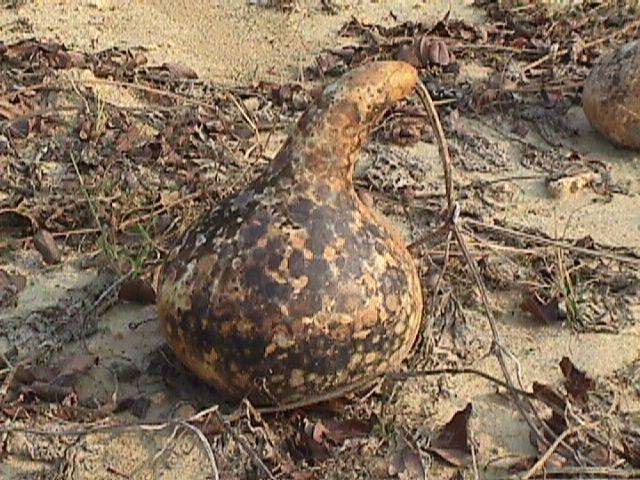

The following are a few tips as to
how to grow gourds. Although the information is intended for 'birdhouse gourds',
(Lagenaria), the basic information will work for just about any type of gourd or
vine plant.
First, there are a few basic requirements that must be met before attempting to
grow gourds of any kind with any real success. Gourds of all types require a lot
of sun, water and a long spell of warm weather. Lagenaria, or 'Bird House'
gourds will need about 150 to 180 growing days in order to fully mature to
9" or 10" gourds. Gourds also need one thing that we wouldn't
normally think about. Gourds need room, lots of room. Depending on the type, the
vines often obtain lengths of 30' (feet) or more. I've personally seen them over 50
feet long. They can either be trellised or left to run on the ground, but I've
found my best results are to simply let them go right on the ground, changing the
direction of the vine if necessary. Good soil is obviously a must for any plant
to grow, but there are also a few other things that can be done to give them a
helping hand.
Planting in Hills
One of the most popular methods for growing "any" plants from the vine
family is to plant them in "hills". To do this, dig a hole about a
foot deep and two feet in diameter in an area where it will receive plenty of
sun and water. Then fill the hole about 1/4 to 1/2 way with cow manure or some
other form of compost. These types of compost materials can be found at Wal-Mart or Kmart garden center or
just about any garden shop. You
may even know a farmer that will give you some for free. Good quality 'humus' will also
work very well. Next, cover the 'compost' with about 3 or 4 inches of dirt and
space from about 6 to 12 seeds around the 'hill' and cover them up. As they
grow, their roots go down into the compost and are thus self fertilizing. Once
they are well started, say about 2 or 3 leaves each, thin down to the best 2 or
3 plants. With good sun and water, they will soon begin spreading their vines.
Just beware, the vines will soon overtake a large area, so don't place the
"hills" too close together. It is not uncommon for the vines of the
larger gourd species to easily reach 20, 25, even 30 feet in length. I assume
that a plant can handle and grow 2 good gourds each, so, with that in mind, you
could expect 20 gourds from 10 plants, depending on your local and length of
growing season. Just remember, the more gourds per plant, the smaller they will
be. And depending on the pollination, some will have gourds, some won't.
More about this later.
Something different.
It's been said that gourds 'thrive on neglect'. In other words, plant them and
leave them alone. Don't pamper them! Believe it or not, this is what one of my farmer friends does
to get his gourds. He goes out near an old wagon that sits out in the open where
it gets plenty of sun. He then pushes some seeds into the ground around it and
leaves them alone all summer. The gourds grow all around and up onto the old
wagon. At the end of the year, around the time the growing season has come to an
end, or the weather has turned cool, he picks his gourds and sets them on the
wagon to dry. He leaves them there until I pick them up and bring them home to
work them into Purple Martin houses. This works for him. Every year he has 30 to
50 beautiful gourds that he can either use or give away to be used for the
martins.
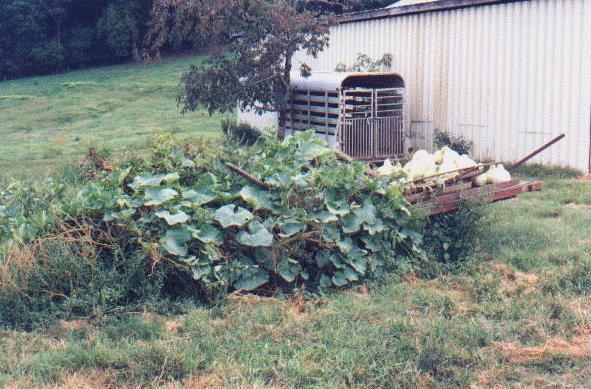
My Point
I guess what I'm trying to say here is that there are no special rules that have to be followed with growing gourds. They don't have to be coddled and fretted over. Just plant the seeds in a good place out in the open and give then a chance to do their thing. Just be prepared. With good soil, lots of sun and regular watering, the vines will grow to a long length and will overtake anything within 20 to 30 feet. They love chain link fences, a special made trellis, or even an old wagon, just as well as open gardens, however, I prefer to plant mine in a garden. Lots of room for me to maneuver around them as they are growing. Once or twice during the growing season, I walk through the plants and set the gourds 'up'. That way, I get good uniformity in shape and they all look like what I want as a finished product when they are done growing. This standing them up often gives the neck a little bend to it and it also makes the 'stem' curl outward. When I make them into bird houses, I cut the stem about 2 inches long and place the entrance directly under this stem. That way, the martins have a little something extra to perch on while guarding their gourd. Some folks don't keep the stems, but I happen to like the looks of the stem when it's mounted on the racks.
When should I plant?
If you live in the southern zones, simply plant when the last threat of frost is past. If gourd seeds are planted and it turns cold again, don't fret. The seeds will simply lay dormant until the soil warms up enough for them to sprout, usually around or above 60 degrees. Then you'll see gourds growing all over the place.
We live in the Northern part of
the country and summers here are short. Is there something we can do to help our
gourds get a head start?
Folks in the south don't have this problem. Spring comes plenty early
enough that you can plant the seeds directly in the ground and when the soil is
warm enough, they will begin to grow.
However, if you live in the northern part of the country where the growing season is
shorter, one thing that can be done is to start the seeds outdoors in what is
called a 'frame' or indoors in trays before the growing season and then
transplanting the young plants outside on the hills or rows when the weather is
warm enough to plant. This will give your plants a head start on the
growing season. Here's a short description of starting gourd seeds inside the
house or outside in a 'cold frame'. Smaller versions for use inside of a house
are often called 'flats'. Small flats built for use inside your house in a
window should not have a top on them. The heat will quickly kill the young
plants.
The best method is to start by making a 'frame' or small hothouse outside. This
is done by nailing some boards together to make a small frame and lay it on the
ground in a good sunny area. The dimensions for the frame are approximately
30" by 60" by about 12" to 18" high. (The dimensions given are basic and
you can make yours to your own dimensions).
Next, you need to make a door that will fit the top of your frame. This door
will contain either clear plastic sheathing or glass, your preference. This door
has to be removable or better yet, hinge in the rear so you have access to the
frame. (An old aluminum storm door with glass in it will work just fine). If you make
a good one from treated lumber, it will last you for years, and you could start
any kind of transplantable plant you like in it.
Now fill the frame to about 6" or 8" with a good potting medium such as
humus. Make sure that you have at least 6" between the top of the dirt and
the door or your young plants will grow up into the glass. 9" is even
better.
Once the temperature outside reaches a reasonable level, say in the 40's during the day, you can consider planting the seeds in the frame. You don't want to do it when the temps are freezing during the day. It will be even colder at night and a hard freeze can be deadly to young plants or propagating seeds. The seeds should be planted about 4 or 5 weeks before regular planting times in your area.
Acquire some 4"
peat pots and fill them with a good humus. These will be used to start
your seeds in. In each pot place 3 seeds.
Then place these seed pots in the frame, burying them into the potting
medium. Moisten with a little water and then close the top. Then sit back and wait.
Depending on the temperatures, within a week or two, the seeds should be sprouting and the young shoots should
start poking their heads out. As they grow, cull back to one plant per
pot. Pick the best one and clip off the other 2.
A couple of tips here.
When it's time to plant, try not to disturb the roots. This will stunt their growth and they won't do very well. When transplanting time comes, plant the entire peat pot with the gourd plant inside of it. The roots of the plant will soon work their way thru the peat pot into the soil around it.
Also, set a thermometer in the frame where it will not get direct sunlight so
you can keep an eye on the temperature inside the frame. If it gets too hot, say
anything over 100 degrees, then you'll want to prop the door open an inch or two
to let the hot air out and some cool air in. On the colder days, you may not
need to open it at all, but as the temperature climbs outside, it will also
climb inside the frame. The temp can be controlled a little by the amount the
door is propped open.
One other thing. The larger the frame is, the easier it is to control the
temperature. That's why the minimum size of the frame should be 30" x
60". Smaller than that, and the temperature fluctuates too quickly to
control accurately.
|
|
|
Another tip
Make some humus now. Humus is very good to start your seeds in and is easy to make. It's nothing more than compost. I have a couple of large piles of it going all the time... (My wife is a flower and garden nut and it's great in the flower beds). We live out in the country, so for me, it's just a matter of piling up all my yard debris. If you are located where a pile of debris might not fit the 'decor' of the neighborhood, then a compost pile is easily made by driving a couple of posts in the ground and then nailing a couple of 4 x 8 sheets of 'treated' plywood to the posts so that you create a 3 sided box. Then throughout the year, throw your grass clippings, raked leaves (run thru the lawn mower to chop them up) or any other thing that was growing, but is now and for what ever reason, dug up and of no value to you any more. Throw all this material in the box and let it set. Use a fork and every couple of weeks, turn it all over, mixing the contents. In dry spells, I turn the hose on it to keep it moist. You'll be surprised at how quick you can make some great humus to grow things in. (Just don't tell your wife about it if she's a flower nut). This humus can then be added to your 'hills' to grow your gourds.
OR...
Another thing that can be done is to simply make a humus pile and then put the seeds directly in the humus pile. I've had great success doing it this way. No need to turn the soil to make a garden or anything like that. I simply pile up all my leaves and grass clippings and throw them all into one big pile that is out of the way and let them compost. About once a month I go out with a fork and turn the piles to speed composting. If you don't have enough leaves and grass clippings to make a decent pile, you can go and pick them up on the curbsides in town. Many folks rake and bag their leaves or grass clippings and then set them out on the curb to be picked up by city workers. You can get to know these folks by simply stopping and talking to them and they just might keep them for you to pick them up. Or you can simply drive around till you find some and load them into your vehicle and take them home and then dump them onto your humus pile. Get as much as you can...it breaks down considerably and you'll end up with a pile that is a whole lot smaller than you started out with.
Then in the spring when the weather is consistently above 60 degrees, simply push your gourd seeds into the mulch pile and let them go. You'll be surprised at just how many gourds you can grow. The mulch piles have all the nutrients that the gourds need and they usually retain plenty of moisture for the gourd vines. If not, turn the hose on the pile for a few minutes. The excess will drain out, but the gourd plants will get plenty and will do great.
How close should I plant my
seeds or young plants in the hills?
Don't put your seeds real close together. If you make a 2 foot diameter hill,
spread about 6 seeds out around the hill. Then, when they are about 6 inches
tall, cull down to the best 2 or 3 plants. If you are transplanting young
plants, then I would put only 3 plants equally spaced around the hill.
If you're planting in rows or some other method, plant your seeds or young
plants at least 3 feet apart. Remember, these plants are going to get rather
large as they grow. 36" spacing is a minimum because the plants will need
to have room to gather nourishment from the soil and their roots will need room
to spread out.
I want to grow my gourds in rows. Will that work OK?
Absolutely. That's how I do it. I put my seeds out in the spring and from then on, just let them go. I prefer the rows because it allows the vines to spread out and I can go back and 'trim' the vines if I like, plus, I can stand them up while they're growing so I get the shapes I want.
No, you don't have to put anything under your gourds. Gourds will grow and dry just fine left right on the ground. Then, at the end of the year when they are totally brown, go get them and put them somewhere that is dry.
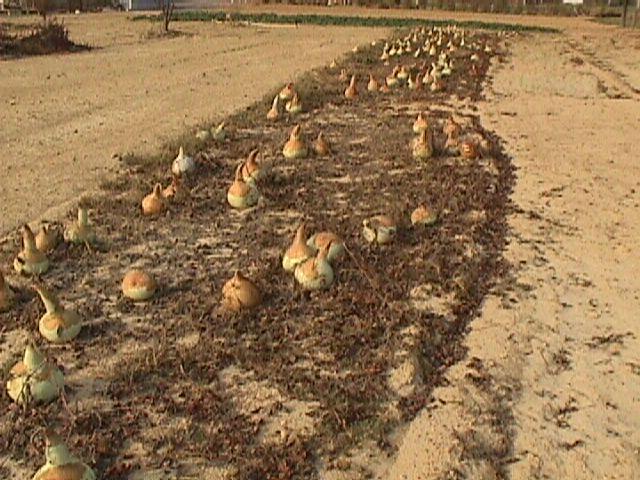
One note: If gourd seeds are planted before the soil is warm enough, they will lay dormant until the soil is warm enough to grow. Then, suddenly you'll see gourds growing all over the place.
The vines from my plants are getting too long for me to get between the
rows with my cultivator. What do I do?
Nothing. Just stop cultivating and let them go. Gourds have a very shallow root
system and once the vines are established, they really don't need any more
tending. A good healthy gourd plant will overtake other vegetation and usually
the leaves will be thick enough that they will prevent the sun from getting to
other plants and thus, they can't grow.
My gourds are sitting on the bare ground. Is this bad for them?
Not at all. As long as the gourds are green and growing, there is no problem
with them sitting on the ground and in fact, even after they fully dry, they will be just fine for a long
time without any threat of decay. It takes a couple of years for a gourd to rot.
As you can see, mine set directly on the ground. However, about
half way through the growing season, I like to walk through the vines and stand
the gourds up so they will 'fill out
evenly' and have nice form during the growing process. I like a small curve
in my gourd necks (like shown below) and standing them up early in the growing
cycle accomplishes this. If
they are hung from a trellis of some sort, then the necks will be very straight.
Also, since I use my gourds for martin housing, I drill them so that the neck
sticks out when hung and the martins love to sit on them while protecting their
holes.
.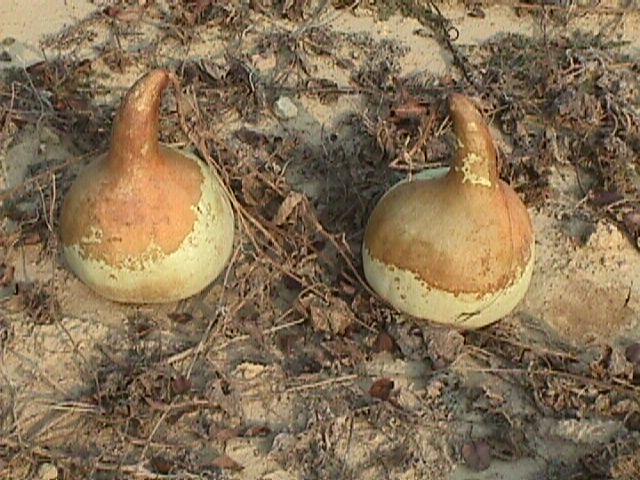
I have a lot of gourds on my plants, but they're not very big. How can I
get my plants to produce bigger ones?
Like anything else, there is only so much food one plant can produce for its
fruit. Gourd plants are no different. Here's a tip that will help produce fewer,
but larger gourds.
Gourd plants produce one main vine. This is where you will find the male
blossoms, (staminate), and of course, this is where the male pollen comes from
for pollination. Then, at intervals, this main vine produces side vines, or
'laterals'. This is where the female blossoms, (pistillate) reside and where you
will find the gourds being produced. Watch your plant as it grows. During bloom,
you should see small gourds starting to grow on the side vines. If you set out
to produce a specific amount of gourds per plant, for instance, 2 or 3 gourds
per plant, then you want to remove any extra gourds from the vines. Simply
clip off the smaller gourds with pruning shears. And yes, some excess
vines can be cut off.
Be careful, don't cut off the vines with the gourds on them. Cutting back
your gourd vines is done like this.
Find the end of a vine.
Now, follow it back to its first junction. If nothing is growing on it,
then simply clip it at the junction using a pair of pruning shears. Again,
find another end, follow it to the junction and clip it. Continue
this until a good bunch of the 'excess' vines are removed. By trimming
from the tips of the vines, you won't make a mistake and cut the wrong vines
with the gourds on them. When you come to a gourd that you want to keep,
clip the vine leaving about a foot or two of extra vine BEYOND the gourd.
If I do clip, I usually leave one
or two extra leaves. The object is to leave about half the original vines on the plants.
Also, to get good gourd size and growth, I rarely
leave more than 2 or 3 gourds on a single plant. I have a lot of room and
sometimes, I find only one or two gourds that I feel are worth keeping. In
this case, I remove all the others so that all the nutrients will go to these.
Once you have your magic number of
gourds established, you can pinch or cut any remaining blooms and gourds from
the vines. Do this by simply clipping them near the vine and discarding them.
This will force the plant to put all its food into the remaining vines and
gourds. This will usually produce only a few, but very large gourds. And, if you
stop to think about it, if 1 plant is able to produce 3 gourds and you have 10
plants, that will make 30 large gourds, and that's a lot of gourds.
One other note: Sometimes, for whatever reason, a gourd will shrivel up
and die. Don't let it bother you. It's just one of those things that happens in
nature and you really can't do anything about it. It might have been
diseased or a borer might have gotten to it and besides, if it was defective,
it's better that it did rot.
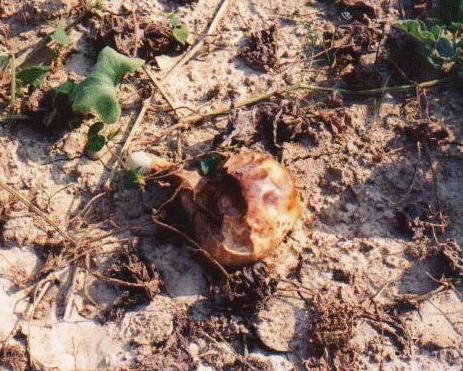
What
about fertilizing my gourds?
Yes, there are a couple. If you can find any cow manure, some of this
spread throughout the garden will do wonders.
If you don't want to get into the cow manure, you could water your plants down with a fertilizer called "Miracle Grow". But this should only be used to get your plants started. Miracle Grow produces 'foliage' and that helps your plants get started. All you do is mix this per the instructions on the can and then water your plants with it. Also, Miracle Grow should only be used one time. It was developed to create greenery for house plants and you'll quickly find out you don't need that with gourds. Also, using Miracle Grow is fine if you only have a few plants, but probably one of the easiest ways to fertilize your gourds is to throw a hand full of triple 13, (13-13-13) on them and let them go. Don't need a lot, just a hand full sprinkled around the hill or spread out down the rows is plenty. Once all of it has been absorbed by the plants, then add another handful. Probably a couple 3 times a year.
Also, remember this, gourds 'need' potash. It's what makes the gourds large and thick walled. Do not be afraid to make sure that the plants get plenty of potash. Planting your seeds with a good amount of 'humus' will help immensely.
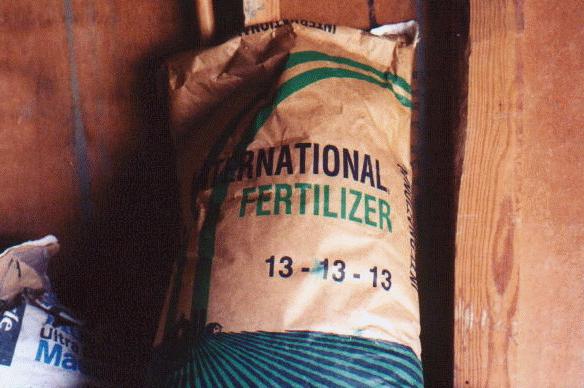
What is the easiest way to tell
how big my gourds are?
Here's about the easiest way I've found to tell the size of your gourds.
Purchase or find a "tailors' tape measure". It's made of cloth and is
very flexible and will go around a gourd with ease, and, you can keep it in your
pocket. Measure the gourd around its largest diameter, or the bulb. If it reads
27", then it is big enough to use for Purple Martins. Divide the number
that you get by 3 and that will give you the diameter of the gourd. IE, 27"
/ 3 = 9" (remember from High School math, the circumference of a circle
divided by "Pi" (3.1417) will give its diameter. Using 3 even is close
enough for our purposes and it's easier than using a calculator). So, if your
gourd measures 27" or larger, it will work just fine for martins. And
remember, the bigger, the better.
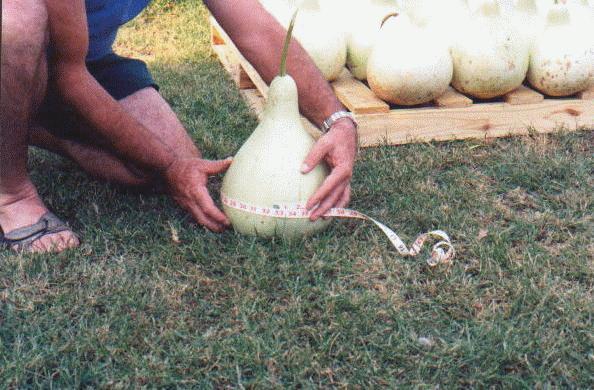
How big should the gourds be to
use for martin houses?
I would consider 9" to be the absolute minimum size gourd to use for purple
martins. Anything smaller is not fit for martin use. I personally feel gourds
should be at least 10" in diameter at the bulb, or 30" on your tape
measure. Martins are the largest member of the swallow family and can raise as
many as 7 young. Anything smaller than 9" is too small and the birds will
be much too crowded. I know that not all gourds can be that big, but try
to make them as large as possible. Start your housing with as many big 10 inchers' as
you can. Then, fill in with the smaller 9 inchers'. Then, each
season, replace as many 9 inchers' as you can with 10 inchers. And remember, these are things of
nature and they won't always be perfect. We are looking for approximations that
will get us in the general area of size and shape. Gourds will grow to any
number of different sizes and shapes and some of them will be rather
interesting. It's your choice which ones you will want to use as martin
houses.
HELP!!! I bought some seeds and the gourds don't look like the ones I
thought I was getting. What happened?
Welcome to the world of gourds. Most of the gourd family will cross pollinate.
When a professional grower plants his crop, he tries to keep the different
species segregated, but he's not always successful. The natural pollinators such
as honeybees and moths, are able to fly from crop to crop looking for the nectar
and pollen. They don't care what type of flower it is, just that it has nectar
and pollen. Thus, they fly from flower to flower, crossing over the lines of
distinction the grower intended. Bingo, you have cross pollination. Now the
stage is set for a possible surprise. Granted, you have seeds, but you won't
know for positive what you're going to have until they grow the following year.
Most of the time you will get what is pictured on the package.
Also, be prepared to be surprised. Why? Because gourds don't necessarily follow the genes from the plant they came from, but may still have traits from the previous year. This means they will still have traits from the gourds you grew " 2 " years ago. Yes, it helps to start out with good seeds, but it talks a few years and generations of gourds to get good quality seeds to grow good quality gourds. This is why gourds often don't replicate the ones they came from. It's just one of the quirks of gourd growing. However, after a few years of replanting and selecting the seeds from the best gourds each year, the ones you really want will be achieved.
Why is it that some of my flowers have small gourds under them and others don't?
The difference is, the ones 'without' the little gourds are 'male' blossoms and the ones 'with' are 'females'. If pollinated, the little gourds under the female blossoms will turn into actual gourds. If not pollinated, then they will simply shrivel up and die.
Why is it I never see any honeybees around my blossoms? I thought they were supposed to pollinate my gourd blossoms.
Actually, 95% of the pollinating of gourds is done after dusk has set in. Honeybees will visit your flowers occasionally, but if you notice, the flowers are usually closed during the day. Then, just before dark, they open up. This is usually when your gourds are pollinated, and although not always, it's usually the Sphinx Moths that do the pollinating. (They are also known as Hummingbird Moths). These are very large moths and are much better adapted to pollinating large gourd flowers than the little honeybee. When your gourds are in full bloom check them around dark and you should notice one or two of them around. If not, then you may have to pollinate them by hand.
OK, so how do I pollinate them by hand?
Hand pollinating is done by taking a small pointed artists brush and once the flowers are open, dipping it into the blossoms, alternating from male to female and so on. Remember, the females have the little gourds under them. This should be done when there are a lot of blossoms so you get a good cross of pollen.
And if I don't hand pollinate...?
If the blooms don't get pollinated, then the little gourds under the female blossoms will soon rot and fall off. And if this happens, then you won't get any gourds.
My vines are wilting. The
leaves are turning brown and dieing and I can't seem to find anything wrong with
them.
That's because there's probably nothing wrong. Actually, this is very normal. The first leaves to grow on the vines are
the first ones to die. As your vines get longer, the leaves out towards
the growing vines are nice and green, but as the vine grows, the leaves back
near the main plant roots turn brown, shrivel up and die. They are
no longer needed so the plant does away with them. If you notice the
opening picture on this page, that's what has happened and all that's left is
the live vines feeding the gourds.
How will I know when my gourds are ready to pick.
That's easy. Leave them right in the field, attached to the vines. Let everything, including them, turn brown and dry up. No, rain and cold won't bother them. Once this happens pick the gourd up and shake it. If it's dry then the seeds should rattle inside. Now you can use your pruning shears and clip the vine leaving about 2 inches of vine on the gourd. That's all there is to it. They are now ready to be made into martin houses.
But it's getting cold. Won't my gourds freeze if it gets too cold?
Yes, they might. But it usually doesn't hurt them. In fact, picking your gourds too early is the worst thing you can do to them. The cold simply kills off the vines. The gourds themselves will easily withstand cold temperatures and in fact, will continue to dry right on the vine.
